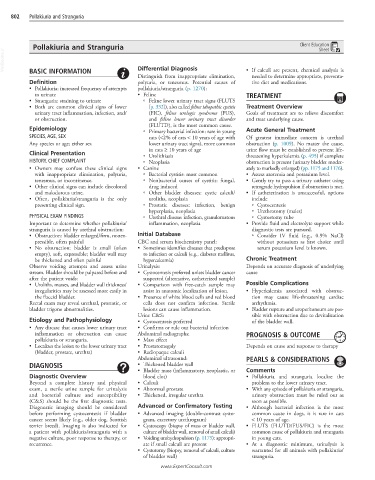Page 1595 - Cote clinical veterinary advisor dogs and cats 4th
P. 1595
802 Pollakiuria and Stranguria
Pollakiuria and Stranguria Client Education
Sheet
VetBooks.ir Differential Diagnosis
BASIC INFORMATION
Distinguish from inappropriate elimination, • If calculi are present, chemical analysis is
needed to determine appropriate, preventa-
Definition polyuria, or tenesmus. Potential causes of tive diet and medications.
• Pollakiuria: increased frequency of attempts pollakiuria/stranguria (p. 1270):
to urinate • Feline TREATMENT
• Stranguria: straining to urinate ○ Feline lower urinary tract signs (FLUTS
• Both are common clinical signs of lower [p. 332]), also called feline idiopathic cystitis Treatment Overview
urinary tract inflammation, infection, and/ (FIC), feline urologic syndrome (FUS), Goals of treatment are to relieve discomfort
or obstruction. and feline lower urinary tract disorder and treat underlying cause.
(FLUTD), is the most common cause.
Epidemiology ○ Primary bacterial infection: rare in young Acute General Treatment
SPECIES, AGE, SEX cats (<2% of cats < 10 years of age with Of greatest immediate concern is urethral
Any species or age; either sex lower urinary tract signs), more common obstruction (p. 1009). No matter the cause,
in cats ≥ 10 years of age urine flow must be established to prevent life-
Clinical Presentation ○ Urolithiasis threatening hyperkalemia (p. 495) if complete
HISTORY, CHIEF COMPLAINT ○ Neoplasia obstruction is present (urinary bladder moder-
• Owners may confuse these clinical signs • Canine ately to markedly enlarged) (pp. 1175 and 1176).
with inappropriate elimination, polyuria, ○ Bacterial cystitis: most common • Assess azotemia and potassium level.
tenesmus, or incontinence. ○ Nonbacterial causes of cystitis: fungal, • Gently try to pass a urinary catheter using
• Other clinical signs can include discolored drug induced retrograde hydropulsion if obstruction is met.
and malodorous urine. ○ Other bladder diseases: cystic calculi/ • If catheterization is unsuccessful, options
• Often, pollakiuria/stranguria is the only uroliths, neoplasia include
presenting clinical sign. ○ Prostatic diseases: infection, benign ○ Cystocentesis
hyperplasia, neoplasia ○ Urethrotomy (males)
PHYSICAL EXAM FINDINGS ○ Urethral disease: infection, granulomatous ○ Cystostomy tube
Important to determine whether pollakiuria/ inflammation, neoplasia • Provide fluid and electrolyte support while
stranguria is caused by urethral obstruction: diagnostic tests are pursued.
• Obstruction: bladder enlarged/firm, nonex- Initial Database ○ Consider IV fluid (e.g., 0.9% NaCl)
pressible, often painful CBC and serum biochemistry panel: without potassium as first choice until
• No obstruction: bladder is small (often • Sometimes identifies diseases that predispose serum potassium level is known.
empty), soft, expressible; bladder wall may to infection or calculi (e.g., diabetes mellitus,
be thickened and often painful hypercalcemia) Chronic Treatment
Observe voiding attempts and assess urine Urinalysis: Depends on accurate diagnosis of underlying
stream. Bladder should be palpated before and • Cystocentesis preferred unless bladder cancer cause
after the patient voids: suspected (alternative, catheterized sample)
• Uroliths, masses, and bladder wall thickness/ • Comparison with free-catch sample may Possible Complications
irregularities may be assessed more easily in assist in anatomic localization of lesion. • Hyperkalemia associated with obstruc-
the flaccid bladder. • Presence of white blood cells and red blood tion may cause life-threatening cardiac
Rectal exam may reveal urethral, prostatic, or cells does not confirm infection. Sterile arrhythmia.
bladder trigone abnormalities. lesions can cause inflammation. • Bladder rupture and uroperitoneum are pos-
Urine C&S: sible with obstruction due to devitalization
Etiology and Pathophysiology • Cystocentesis preferred of the bladder wall.
• Any disease that causes lower urinary tract • Confirms or rule out bacterial infection
inflammation or obstruction can cause Abdominal radiographs: PROGNOSIS & OUTCOME
pollakiuria or stranguria. • Mass effect
• Localizes the lesion to the lower urinary tract • Prostatomegaly Depends on cause and response to therapy
(bladder, prostate, urethra) • Radiopaque calculi
Abdominal ultrasound: PEARLS & CONSIDERATIONS
DIAGNOSIS • Thickened bladder wall
• Bladder mass (inflammatory, neoplastic, or Comments
Diagnostic Overview blood clot) • Pollakiuria and stranguria localize the
Beyond a complete history and physical • Calculi problem to the lower urinary tract.
exam, a sterile urine sample for urinalysis • Abnormal prostate • With any episode of pollakiuria or stranguria,
and bacterial culture and susceptibility • Thickened, irregular urethra urinary obstruction must be ruled out as
(C&S) should be the first diagnostic tests. soon as possible.
Diagnostic imaging should be considered Advanced or Confirmatory Testing • Although bacterial infection is the most
before performing cystocentesis if bladder • Advanced imaging (double-contrast cysto- common cause in dogs, it is rare in cats
cancer seems likely (e.g., older dog, Scottish gram, excretory urethrogram) < 10 years of age.
terrier breed). Imaging is also indicated for • Cystoscopy (biopsy of mass or bladder wall, • FLUTS (FLUTD/FUS/FIC) is the most
a patient with pollakiuria/stranguria with a culture of bladder wall, removal of small calculi) common cause of pollakiuria and stranguria
negative culture, poor response to therapy, or • Voiding urohydropulsion (p. 1175): appropri- in young cats.
recurrence. ate if small calculi are present • At a diagnostic minimum, urinalysis is
• Cystotomy (biopsy, removal of calculi, culture warranted for all animals with pollakiuria/
of bladder wall) stranguria.
www.ExpertConsult.com

